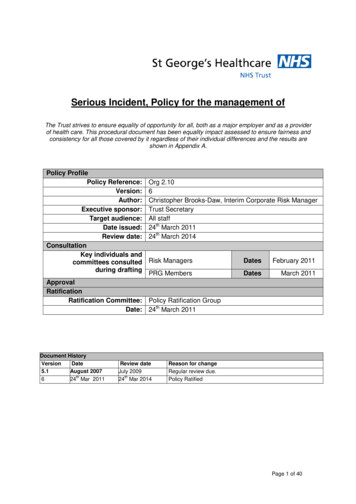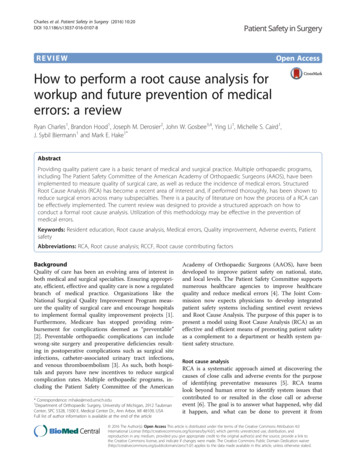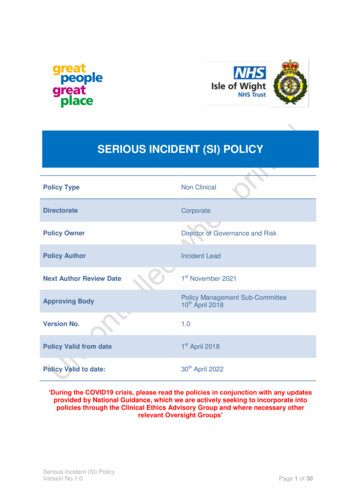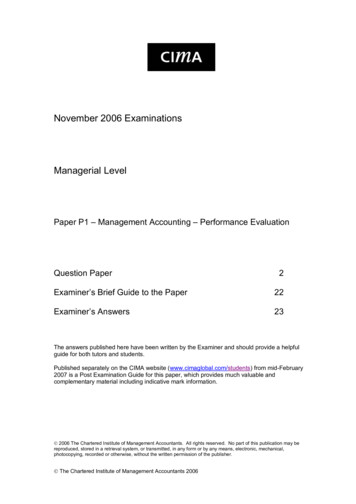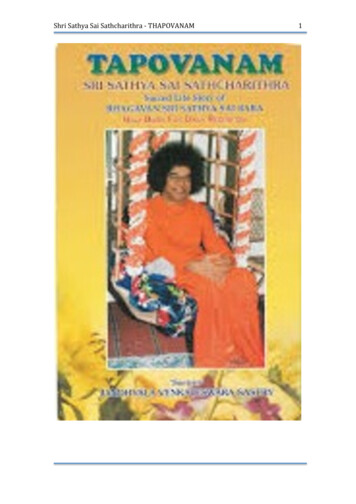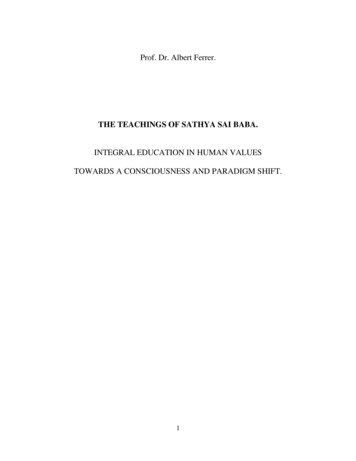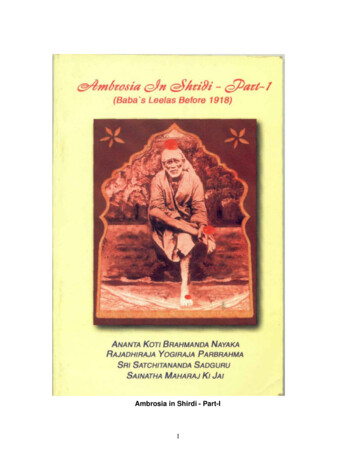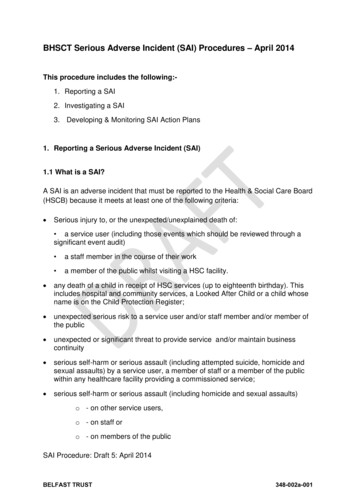
Transcription
BHSCT Serious Adverse Incident (SAI) Procedures – April 2014This procedure includes the following:1. Reporting a SAI2. Investigating a SAI3. Developing & Monitoring SAI Action Plans1. Reporting a Serious Adverse Incident (SAI)1.1 What is a SAI?A SAI is an adverse incident that must be reported to the Health & Social Care Board(HSCB) because it meets at least one of the following criteria: Serious injury to, or the unexpected/unexplained death of: a service user (including those events which should be reviewed through asignificant event audit) a staff member in the course of their work a member of the public whilst visiting a HSC facility. any death of a child in receipt of HSC services (up to eighteenth birthday). Thisincludes hospital and community services, a Looked After Child or a child whosename is on the Child Protection Register; unexpected serious risk to a service user and/or staff member and/or member ofthe public unexpected or significant threat to provide service and/or maintain businesscontinuity serious self-harm or serious assault (including attempted suicide, homicide andsexual assaults) by a service user, a member of staff or a member of the publicwithin any healthcare facility providing a commissioned service; serious self-harm or serious assault (including homicide and sexual assaults)o - on other service users,o - on staff oro - on members of the publicSAI Procedure: Draft 5: April 2014BELFAST TRUST348-002a-001
by a service user in the community who has a mental illness or disorder (asdefined within the Mental Health (NI) Order 1986) and known to/referred tomental health and related services (including CAMHS, psychiatry of old age orleaving and aftercare services) and/or learning disability services, in the 12months prior to the incident; suspected suicide of a service user who has a mental illness or disorder (asdefined within the Mental Health (NI) Order 1986) and known to/referred tomental health and related services (including CAMHS, psychiatry of old age orleaving and aftercare services) and/or learning disability services, in the 12months prior to the incident; Serious incidents of public interest or concern relating to: any of the criteria above theft, fraud, information breaches or data losses a member of HSC staff or independent practitionerAny adverse incident which meets one or more of the above criteria should bereported as a SAI.1.2 How to Report a SAIIf an adverse incident occurs which meets or seems to meet any of the above criteriait should be reported immediately through the reporters management line andultimately to Director or Co-Director for consideration for reporting as a SAI (thedirectorate Governance & Quality Manager or equivalent, should also be included inany communication). This should be done urgently and in the form of verbal as wellas email communication.When Director/Co-Director agrees to report the incident as a SAI, the relevantManager or Governance & Quality Manager should then complete the SAINotification form report, send it to the Director / Co-Director for approval and forwardthe approved copy (including details of who approved it) to the CorporateGovernance Department SAI mailbox (address below) for onward reporting to theHealth & Social Care Board (HSCB). This form can be found on the Trust Intranet atthe following link:Link to be set upSAI Procedure: Draft 5: April 2014BELFAST TRUST348-002a-002
The form can also be obtained by emailing your request to Serious Adverse Incidentmailbox SeriousAdverseIncident@belfasttrust.hscni.net (Also in Outlook addressbook) or by contacting Corporate Governance Services on Tel: 028 950 48098.(The Serious Adverse Incident mailbox should also be used for all SAIcorrespondence with Corporate Governance and external bodies.)Corporate Governance will then check and redact the SAI Notification form and giveit a BHSCT SAI reference number. The form will then be forwarded to the HSCB andif applicable to the Regulation and Quality Improvement Authority (RQIA).A Trust Incident Report Form should also be completed as soon as possible (if notalready done so) as per Trust procedures.(All Adverse Incident policies and procedures can be found in Policies & Guidelinespage of Trust Intranet under the Medical Directorate/Risk & Governance subfolders.)1.3 TimescaleAll SAIs are required to be reported to HSCB within 72 hours of the incident beingdiscovered.1.4 General guidance on completing the SAI Notification formGuidance on completing the SAI Notification for can be found at Appendix 1. Thefollowing points should be read in conjunction with those procedures:Sections to completeComplete all of the following sections (Corporate Governance will complete theremainder)Sections 3, 4, 5, 6, 8 (excluding CCS coding), 9, 10, 11, 12, 13, 14, 15, 16, 17 and18.Section 8: Incident Description: Provide a brief factual description of what has happened and a summary of theevents leading up to the incident. Please ensure sufficient information is providedso that the HSCB/PHA is able to come to an opinion on the immediate actions, ifany, that they must take. Where relevant include D.O.B, Gender and Age.SAI Procedure: Draft 5: April 2014BELFAST TRUST348-002a-003
All reports should be anonymised – the names of any practitioners or staffinvolved must not be included. Staff should only be referred to by job title.1.5 Informing the service user / family / carerThe principles of the Being Open policy must be adhered to when communicating toservice users, their families or carers regarding the reporting of a Serious AdverseIncident. Where it is clear or suspected that a SAI has resulted in unexpectedserious harm or death to a service user rapid and open disclosure and emotionalsupport should be given.The Co-Director responsible for the SAI is also responsible for ensuring the serviceuser / family / carer is communicated with appropriately regarding the SAI andsubsequent investigation. They will nominate the appropriate person to speak withthe service user / family / carer initially and also ensure the service user / family /carer has a link person to contact throughout the SAI process as required. Aninformation leaflet1 covering “What do I need to know about Serious AdverseIncidents” should be given to the service user / family / carer to include contactdetails for the link person. NB -This leaflet should only be used when it isconfirmed that a SAI has been reported.If the Service User/Family/Carer has been notified of the incident before completingthe SAI notification form, the appropriate date of notification must be included insection 15 of the form (see appendix 1). If notification is planned and not yetcomplete at the time of reporting, or not planned, the reason(s) should be explainedin the “Others” free text field in section 15 of the form, or where relevant in anyupdated form the HSCB subsequently issues.1.6 Coroner InvolvementDetails of involvement with the Coroner should be included in the description section8 of the Notification form. It is also important to include date of notification of theCoroner if applicable in section 17. When it is known that a death is to beinvestigated as an SAI the Coroner must be notified of this even if previously notifiedof the death.1There are two Trust leaflets informing service users / family / carers about SAIs. One is specifically for AdultSocial and Primary Care and the other is general and should be used in all other areas.SAI Procedure: Draft 5: April 2014BELFAST TRUST348-002a-004
Ensure the form is forwarded by email to the Trust SAI email et along with confirmation of approval bythe relevant Director or Co-Director (name of whom must be provided).1.7 “Query Serious Adverse Incidents” (QSAIs)The responsibility for identifying and decision to report an SAI lies primarily with therelevant directorate responsible for that incident. To support directorate incidentreview processes and to act as a further barrier to delayed reporting, the CorporateGovernance department may query any incident report where an SAI criteria seemsto have been met but where the date for reporting the incident as an SAI is overdueand with no indication that it is being reported or considered. This is known as aQuery SAI (QSAI) and “QSAI” is added to the incident reference until closed.Once an incident is identified as being a query SAI (QSAI) it is forwarded to therelevant Governance manager or alternative for consideration for reporting as a SAI.The incident will remain open as a QSAI until Corporate Governance receiveseither: A completed approved SAI Notification form relating to the incident, or An investigation report or summary as necessary which includes a clearexplanation of why the incident does not meet the criteria for reporting as anSAI. This should also include any learning and actions taken to prevent reoccurrence where applicable. Please note that the decision not to report as anSAI may be subject to challenge from the Medical Directorate’s office.The response to the QSAI should be sent to the Trust SAI mailbox and anyreport should also be included within the Datixweb incident record andreferenced in the investigation section.SAI Procedure: Draft 5: April 2014BELFAST TRUST348-002a-005
2. Procedure for investigating Serious Adverse Incidents (SAI)The following procedures for investigation of Serious Adverse Incidents (SAI) arebased on, and should be read in conjunction with, the HSCB SAI Procedure forReporting and Follow up of Serious Adverse Incidents October 2013.When reporting a SAI, the responsible Director / Co-Director (in conjunction with theMedical Director if considering a level 3) must decide on the level of investigationrequired and this must be indicated on the SAI Notification form (section 18). Thereare 3 levels of investigation available for SAIs and these are explained below with asummary table for quick reference.2.1 Level of SAI InvestigationSAI investigations should be conducted at a level appropriate and proportionate tothe complexity of the incident under review. In order to ensure timely learning of allSAIs reported, it is important the level of investigation focuses on the complexity ofthe incident and not necessarily on the significance of the event.SAIs will be investigated using one or more of the following:Level 1 Investigation – Significant Event Audit (SEA)A level 1 investigation requires the use of Significant Event Audit (SAE) investigationmethodology to investigate the incident. For guidance on using SEA methodologyplease see NPSA SEA guidance link.SAI notifications which indicate a level 1 investigation will enter the investigationprocess at this level and a SEA will immediately be undertaken to: assess why and what has happened agree follow up actions identify learningThe possible outcomes may include: no action required identification of a learning need and actions sharing the learning Requires Level 2 or 3 investigation.The SEA report must be completed, approved by the relevant Director or Co-Directorand sent to the Trust SAI mailbox for onward reporting to the HSCB within 4 weeksof the SAI being reported.SAI Procedure: Draft 5: April 2014BELFAST TRUST348-002a-006
If during or on completion of the SEA the investigating team determines the SAI ismore complex and requires a more detailed investigation, the investigation will moveto either a level 2 or 3 investigation.If a Level 2 RCA is required, the SEA report will still be forwarded to the HSCB within4 weeks of the SAI being reported along with completed sections 2 and 3 of the RCAtemplate to include Team Membership and Terms of Reference of the teamcompleting the level 2/3 investigation. The level 2 RCA process will then need to beinitiated (see below). It may be possible to retain the same team but the level ofindependence needs to be considered and the Co-Director will need to contactCorporate Governance who oversee a pool of level 2 investigators (see below).In most circumstances, completed SEA investigations at this level will be adequatefor incidents involving no harm and low harm and/or where the circumstances are ofa less complex nature. In these instances it is more proportionate to use a conciseSEA to ensure there are no unique factors and then focus resources onimplementing improvement rather than conducting a comprehensive investigationthat will not produce new learning.Any learning from these investigations should be shared as appropriate within theDirectorate governance structures and in accordance with the Trust SharingLearning procedure (appendix 2). If there is significant learning at any stage of theSEA process which requires urgent sharing outside the directorate, this should bebrought to the next SAI Group meeting by the relevant Co-Director on aTransferrable Learning Template (see appendix 2).Level 2 – Root Cause Analysis (RCA)Level 2 Investigations will most likely be conducted for incidents of actual or potentialserious harm or death and/or where the circumstances involved are relativelycomplex and may involve multiple processes/teams/disciplines.The investigation should include use of appropriate RCA analytical tools (seeparagraph 2.3 below and NPSA Guidance on RCA methodology on hub insert link)and will normally be conducted by a multidisciplinary team (not directly involved inthe incident) with a degree of independence determined by the complexity of theincident. The investigation should be chaired by someone independent to the servicearea involved as a minimum. The investigation report should be completed using theHSCB RCA report template (see appendix 6 & 7 of HSCB SAI Procedure forReporting and Follow up of Serious Adverse Incidents October 2013).Team membership for level 2 investigations is the responsibility of the commissionDirector / Co-Director. Members will be selected from an established pool ofinvestigators and will be proposed by Corporate Governance to include membersindependent of the directorate concerned, with agreement from the CommissioningDirector / Co-Director. Where the Commissioning Director / Co-Director requiresteam member(s) external to the Trust, Corporate Governance will liaise with thecommissioning Director / Co-Director to propose an appropriate independentmember(s) for inclusion on the team.SAI Procedure: Draft 5: April 2014BELFAST TRUST348-002a-007
Level 2 SAI investigations may involve two or more organisations. In theseinstances, it is important a lead organisation is identified but also that allorganisations contribute to the final investigation report. Corporate Governance willliaise with the other organisation(s) to propose a team member(s).Sections 2 and 3 of the RCA template will be completed and forwarded to the HSCBby, or on behalf of the Director / Co-Director within 4 weeks of the SAI being notified,detailing the membership and Terms of Reference for the level 2 investigation.Any learning from these investigations should be shared as appropriate within theDirectorate governance structures and in accordance with the Sharing learningprocedure (appendix 2). If there is significant learning at any stage of the SEAprocess which requires urgent sharing outside the directorate, this should be broughtto the next SAI Group meeting by the relevant Co-Director on a TransferrableLearning Template (see Sharing Learning procedure).Level 3 – Independent InvestigationLevel 3 investigations will be considered for highly complex SAIs where a highdegree of external/independent representation on the investigation team is required.In some instances all team members may be independent to the organisation/swhere the incident/s has occurred.The timescales for reporting, Chair and membership of review team will be agreedwith the HSCB/PHA Designated Review Officer (DRO) at the outset. TheCommissioning Director / Co-Director and Medical Director should liaise with theDRO through Corporate Governance to agree timescales, team membership andterms of reference.Level 3 investigation reports will take the same format as level 2 and use the sametemplate structure for the final report.Any SAI which involves an alleged homicide perpetrated by a service user knownto/referred to mental health and/or learning disability services will be investigated asa level three incident. In these instances, the Protocol for Responding to a SAI inthe Event of a Homicide, issued in 2010 and revised in 2013 should be followed (seeappendix 13 of HSCB SAI Procedure for Reporting and Follow up of SeriousAdverse Incidents October 2013).2.2 TimescalesNotificationAny adverse incident that meets the criteria of a SAI must be reported within 72hours of the incident being discovered using the SAI Notification Form.SAI Procedure: Draft 5: April 2014BELFAST TRUST348-002a-008
Investigation Reports Level 1 – SEASEA reports must be completed using the SEA template and submitted to the HSCBwithin 4 weeks (6 weeks by exception) of the SAI being notified.Note: Corporate Governance will ask for the final report to be submitted to their office2 days prior to submission date to HSCN to allow for redacting and final checks. Level 2 – RCARCA investigation reports must be completed using the level 2 & 3 report templateand submitted to the HSCB 12 weeks from the initial notification of the SAI to HSCBor, if previously a SEA, 12 weeks from submission of the SEA report.Note: Corporate Governance will ask for the final report to be submitted to their office2 days prior to submission date to HSCN to allow for redacting and final checks. Level 3 – Independent InvestigationsTimescales for completion of level 3 investigations will be set by the HSCB/PHA leadofficer and/or DRO.Note: Corporate Governance will ask for the final report to be submitted to their office2 days prior to submission date to HSCN to allow for redacting and final checks.Investigation Report Extensions Level 1 Investigations – SEAHSCB and PHA will not accept extension requests for this level of investigation.When reporting the SEA, an additional 2 weeks can be sought by exception only withreason given. Level 2 Investigations - RCAIn most circumstances, all timescales for submission of RCA investigation reportsmust be adhered to. However, it is acknowledged there may be some occasionswhere an investigation is particularly complex, perhaps involving two or moreorganisations. In these instances the reporting organisation may request anextension to the normal timescale i.e. 12 weeks from timescale for submission ofinterim update report. However, this request must be approved by the DRO andshould be requested when submitting the interim update report. Level 3 Investigations – IndependentAs per above, all timescales (including possible extensions) must be agreed with theDRO at the outset of the investigation.DRO QueriesSAI Procedure: Draft 5: April 2014BELFAST TRUST348-002a-009
Level 1 Investigations – SEADRO queries must be responded to within 1 week of the query being received Level 2 Investigations - RCADRO queries must be responded to within 4 weeks of the query being received Level 3 Investigations – IndependentDRO queries must be responded to within 4 weeks of the query being receivedMonitoringThe investigation progress will be monitored by the SAI Group and the responsibledirector/ Co-director to ensure timetables are met. A performance report will betabled at each SAI Group identifying any areas where targets are not being met. Therelevant Co-Director will be required to provide explanations for any delays.When the draft final report is complete, the Investigation team chair is advised toshare the report with a Trust colleague independent to the directorate to review. Thereviewer may have comments/feedback which will then be considered by theInvestigation team before finalisation of the report for approval by relevantDirector/Co-director.ActionsThe RCA template (appendix 6 & 7 of HSCB SAI Procedure for Reporting andFollow up of Serious Adverse Incidents October 2013) indicates that an action planshould be included within the Final report for submission to HSCB. This should bedone as far as possible with a final draft Action Plan forwarded as soon as approved.Actions do not need to be complete when submitting the action plan to the HSCB.Further details on the Action Plan can be found in paragraph 3.0 below.2.3 Completion of SEA & RCA templatesGuidance on completing the SEA and RCA templates for can be found at Appendix 5& 6 respectively of the HSCB SAI Procedure for Reporting and Follow up of SeriousAdverse Incidents October 2013. The following points should be read in addition tothose procedures: Jargon or unexplained abbreviations must not be used within the report.Although clinical shorthand would be understandable to other clinicians, aSEA or RCA report is a formal report and not a clinical record. As such itshould be understandable to non-clinicians including the service user / familymembers / carers and the Coroner.SAI Procedure: Draft 5: April 2014BELFAST TRUST348-002a-010
All reference to services, organisations, facilities etc should be explained fullyif not otherwise obvious to the reader e.g. including the name of a housingassociation building without explaining what it is would not suffice. The HSCB RCA template is in tabular form. This may cause formattingdifficulties. It is acceptable to use a blank word document instead but theHSCB section headings from the RCA template must be included.2.4 Service User/Family/Carer involvementHSCB SAI Procedure for Reporting and Follow up of Serious Adverse IncidentsOctober 2013 Paragraph 5.4 should be adhered to and states the requirement forservice user / family / carer involvement in SAI investigations is as follows:“It is important that teams involved in investigations in any of the above three levelsensure sensitivity to the needs of the service user/relatives/carers involved in theincident and agree appropriate communication arrangements, where appropriate.The Investigation Team should provide an opportunity for the service user / relatives/ carers to contribute to the investigation, as is felt necessary. The level ofinvolvement clearly depends on the nature of the incident and the serviceusers/relatives/carers wishes to be involved.”The Co-Director responsible for the SAI should ensure the appropriate level ofinvolvement of service user / family / carer throughout the investigation includingdiscussion / sharing of the final report with the service user / family / carer and thisshould be agreed with the investigation team from the outset.The Co-Director responsible for the SAI should ensure the completion of a SAIInvestigation Report checklist (appendix 3) when submitting Investigation reports toHSCB. This checklist will explicitly describe the involvement (and if not, thecircumstances where it has not happened) of Service Users/Relatives/Carers in theInvestigation and whether they received a final report.Approved SAI final reports should be shared or talked through with the serviceuser/relatives/Carer as appropriate and where this is not done, an explanation mustbe submitted within the SAI checklist and if pending, this should be included as anaction in the subsequent Action Plan for that SAI (see below).In all cases the principles of consent and patient confidentiality must be upheld.For guidance on how to involve families in the SAI investigations please refer to theRCA Guidance on the hub.SAI Procedure: Draft 5: April 2014BELFAST TRUST348-002a-011
Involvement specific to SEA reportsUnder the HSCB timeframe for completing SEAs it may not be possible to involvethe service user / family / carer in the investigation process before the final report issubmitted to the HSCB. In such cases, where family involvement is deemedappropriate, the approved report should be discussed / shared with the family at adate as soon as possible after submission of the report and any issues addressedand those requiring material changes to the SEA report should be added as anaddendum and forwarded to Corporate Governance for sending to HSCB in arevised report.Where a SAI is also a ComplaintWhere a Serious Adverse Incident is also a Complaint, the investigation under theSAI process will take precedence and the Complaints investigation will be put onhold until the SAI investigation is complete. The Complainant must be notified of thisas soon as possible. An information leaflet along with an explanation of the changein process should be given to the Complainant.Note that communication through the complaints process with the Complainantshould continue regarding timescales and any associated delays. The SAIinvestigation process as per above will also have a link person identified tocommunicate with the service user / family / carer and will communicate through thisprocess as appropriate. When complete the SAI final report will be shared with theComplainant and the complaints process remains open until the complaint is formallyclosed with all complaints issued addressed.2.5 Coroner engagementReports should also routinely include in their chronology details of all engagementswith the Coroner where a death has occurred and if the Coroner has not beeninvolved this should be stated and the decision explained.The Co-Director responsible for the SAI should also ensure the completion of a SAIInvestigation Report checklist (appendix 3) when submitting Investigation reports toHSCB. This checklist will explicitly ask if the Coroner has been notified and if thecase has been closed.2.6 Child Protection and Adult ProtectionSAI Procedure: Draft 5: April 2014BELFAST TRUST348-002a-012
Any incident involving the suspicion or allegation that a child or adult is at risk ofabuse, exploitation or neglect should be investigated under the procedures set downin relation to a child and adult protection.If during the investigation of one of these incidents it becomes apparent that theincident meets the criteria for an SAI, the incident will immediately be notified to theHSCB as a SAI.It should be noted that, where possible, safeguarding investigations will run inparallel as separate investigations to the SAI process with the relevant findings fromthese investigations informing the SAI investigation and vice versa. However, allsuch investigations should be conducted in accordance with the processes set out inthe Protocols for Joint Investigation of Cases of Alleged or Suspected Abuse ofChildren or Adults.In these circumstances, the DRO should liaise closely with the HSC Trusts on theprogress of the investigation and the likely timescales for completion of the SAIReport.On occasion the incident under investigation may be considered so serious as tomeet the criteria for a Case Management Review (CMR) for children, set by theSafeguarding Board for Northern Ireland; a Serious Case Review (SCR) for adultsset by the Northern Ireland Adult Safeguarding Partnership; or a Domestic HomicideReview.In these circumstances, the incident will be notified to the HSCB as an SAI. Thisnotification will indicate that a CMR, SCR or Domestic Homicide Review isunderway. This information will be recorded on the Datix system, and the SAI will beclosed.If a CMR is being considered the SAI process may be suspended and the HSCBnotified of this whilst a notification and decision regarding CMR is made.SAI Procedure: Draft 5: April 2014BELFAST TRUST348-002a-013
SAI Procedure: Draft 5: April 2014BELFAST TRUST348-002a-014
Responsible officerActionLearningPlanSAI type (guideonly)Inv.levelInv. tool/ iestimescaleMostly Low/noharm, not complex,minimal learningenvisaged at outsetLevel1SEA4 weeksOutsideServiceArea.SEAtrainedLocal multidisciplinary.No (2 additionalweeks whenreporting SAI,by exception)Director/Co- Director/Co- To SAI1 weekDirectorDirectorgroup ifsharingbeyondDirectorateSEA not sufficient,more complexand/or seriousoutcomeLevel2RCAOutsideServiceArea/Dir.or Trust.RCAtrainedMultidisciplinary /Trustindependentinputpossible.1 extension byexception,sought at 4-6weeks.DirectorDirector/Co- To SAI4 weeksDirector &group ifSAI GroupsharingbeyondDirectorateParticularlycomplex/ multipleorgs involved;requires significantdegree ofindependence; highprofile.Level3RCA12 weeksfrom SAINotification orcompletiondate of SEA.ToR & Teammembershipby 4 weeksTo be agreedwith HSCBOutsideDir orTrust.RCAtrainedHighlyTo be agreedindependentwith ctor &SAI GroupTo SAI4 weeksgroup ifsharingbeyondDirectorateTable 1: SAI Investigation process – Teams, tools and timescalesFor further details please see HSCB SAI Procedure for Reporting and Follow up of Serious Adverse Incidents October 2013SAI Procedure: Draft 5: April 2014BELFAST TRUST348-002a-015
3. Action Plans - Procedure for developing & monitoring SAI Action Plans3.1 IntroductionThese procedures outline the responsibilities and requirements to ensure appropriate actionsare taken to prevent/minimise re-occurrence and share learning.The individual who commissioned the SAI investigation has responsibility for ensuring anyrecommendations and lessons learned are incorporated into a plan of appropriate andrealistic actions (SAI Action Plan).An Action Plan is an important tool to improve systems and implement recommendations frominvestigations into Adverse Incidents:Action Plans for SAIs should be approved by the individual who commissioned theInvestigation (usually Director). When all actions are completed they should be signed off bythe Director/ Co-Director and in the case of Level 2 & 3 SAIs noted as closed at SAI Group.A robust Action Plan should be: explicittime bounddeliverableassign responsibility for the actionmeasurableAvoid actions such as remind staff or promote awareness, but it they have to be used, explainhow this will be done e.g. a poor action would be – shar
Procedure for investigating Serious Adverse Incidents (SAI) The following procedures for investigation of Serious Adverse Incidents (SAI) are based on, and should be read in conjunction with, the HSCB SAI Procedure for Reporting and Follow up of Serious Adverse Incidents October 2013.

